|
Notes: When opened in 1888 the station was called South Shields. In 1900 the station was completely rebuilt and renamed Westoe Lane although tickets issued at the station continued to show the name as 'Shields' until closure of the line. This rebuild included widening the platform across the original track bed.
| Westoe Lane, was the principal station on the railway with a single platform and after 1900 substantial brick buildings with a recessed canopy in front of the booking office. The station was bleak and almost devoid of station notices or signs. There were no platform seats and no porters. A small signal box with 15 levers was provided on the platform in the middle |
 |
of the station buildings, next to the booking office.
Three tracks passed through the station, two were part of the Barton Coal Companies overhead electrified network but the platform road itself was not electrified until 1954 after closure to passengers. After closure the station building remained in use for many years as an office and was eventually demolished c.1980. The site has now been redeveloped for housing.
A one-road shed was built near Westoe Lane station, dating from opening; this was probably the line's first depot. It was officially closed in 1953 but may have been out of use for some time before that date. No pictures of it are known.
BRIEF HISTORY OF THE SOUTH SHIELDS, MARSDEN & WHITBURN COLLIERY RAILWAY
The Marsden Railway was built without an Act of Parliament by the Whitburn Coal Company in the late 1870's, during the development of Whitburn Colliery. The colliery started production in May 1879 and the railway was used to take the workforce to and from the colliery with a miners' platform provided at the colliery and at South Shields (renamed Westoe Lane in 1900).
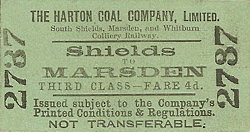 |
Before the colliery was built, Marsden was a very small village consisting of farms, a few cottages and a lighthouse at Souter Point, the only industry in the area was limestone quarrying which was on a small scale. The Whitburn Coal Co. bought five quarries, two of which were developed as the Lighthouse (Marsden) Quarries. The quarries lay next to the new railway and |
were found to have large reserves, which were to provide traffic for the railway.
With the building of the mine and the expansion of the limestone quarries an extra workforce was required. To cater for the influx of new workers the Whitburn Coal Co. built a new village at Marsden. The village was built between the Lighthouse Quarries and Whitburn Colliery. There were 135 houses and around 700 people lived there. The village had nine streets, a church, Methodist Chapel, Co-op store, Miners’ Institute, Post Office and school. Marsden village was situated on the cliff top therefore open to all the elements and with this isolated position, many of the Whitburn miners preferred to live in South Shields using the railway to reach their workplace as at that time there were no direct road links between South Shields and the colliery.
The colliery and the railway got off to a very slow start as the pit was not ready to start full scale operations. By late 1881 the pits annual production was less than 10,000 tons. It was limestone that initially made up most of the mineral traffic on the railway.
| After improvement to the track and signaling had been approved by the Board of Trade a public service was introduced between South Shields and the new village of Marsden (a distance of 2 3/4 miles) on 19th March 1888 with miners' only trains continuing an extra mile to the platform at Whitburn Colliery. The journey time between South Shields and Marsden was ten minutes. Separate trains were provided for the public and colliery workers but after 1913 public passengers and colliery workers used the same train and were directed to the right coach by the guard. Initially the line was known as the Marsden Railway but by the end of the century it had acquired the more grandiose title The South Shields Marsden and Whitburn Colliery Railway. The first timetable only shows a weekday service but Marsden was convenient for Marsden Rock and the bay and the line soon attracted tourist traffic with a Sunday service which was slightly more frequent than the weekday service being introduced in 1881. |
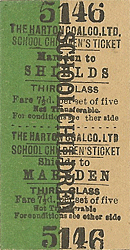 |
In 1891, the Whitburn Coal Company which was, by then, in financial difficulty, was amalgamated with the Harton Coal Company, which continued to work the line.
During the 1920's, South Shields Corporation wanted to build a new coast road and it became necessary to move the railway some 50 yards inland for about 3/4 mile at Marsden. At this time the line was upgraded to a 'Light Railway' under a Light Railway Order of 7th August 1926; this imposed a maximum speed limit of 25mph. The new coast road opened in November 1928.
 |
The deviation rejoined the original alignment close to the site of Marsden Station which was demolished with passengers being carried forward to the colliery platform which was upgraded to a passenger station and renamed Marsden. For some unknown reason Ordnance Survey continued to show Marsden station at its original site until closure of the line and never |
showed the colliery platform as a public station.
The line was single throughout and was worked on the electric staff system. Normal passenger trains consisted of three coaches, plus a guard’s brake at each end hauled by old locomotives withdrawn from other railways usually the North Eastern Railway and later the LNER. In later years three brand new Robert Stephenson & Hawthorn 0-6-0ST tank engines were purchased and delivered in 1949, 1951 and 1952. They were more powerful than the ex-War Department 0-6-0 tank engines that were being used at that time having 4ft driving wheels compared with 4ft 3ins of the Austerity locos. They were specially fitted with Westinghouse brakes to operate the passenger service. They looked much chunkier than usual and got the nickname 'Stubby Hawthorns' After withdrawal of the passenger service, one loco was transferred to Boldon Colliery where its extra power was used to take bigger loads of coal to Tyne Dock Coal staiths. (Click here to see a picture passing thorough Simonside in 1965). The railway always used second hand coaching stock, usually worn out and in poor condition. The public must have found them most uncomfortable. The riding qualities of the carriages gained some notoriety and the service was given the nickname 'The Marsden Rattler' which remained with it until the service ended. The coaches used by the mineworkers were stripped of all interior partitions and fittings and were fitted with wooden seats.
| Despite its shaky start coal production at Whitburn was impressive once the pit was in full production and output was also good at the Lighthouse Quarries. Profits from Whitburn alone for 1913 were said to be in the region of £432,000. The takings for the railway in that year were meagre, amounting to just £264, however this more than covered the running costs. |
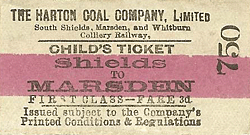 |
The only connection between the Marsden Railway and the national network was provided by the industrial lines of the Harton Coal Company. These lines were electrified in the early years of the 20th century to the newly built staiths on the River Tyne. The electrification was worked off overhead cables at 550 volts DC. Coal traffic from Whitburn Colliery was brought into Westoe Lane, stopping on one of the two electrified tracks there. An electric locomotive then took the train to near Whitburn Junction, if the traffic was to be handed over to the NER (or its successors),
or taken to a marshalling yard if the coal was to be shipped by sea from the Tyne staiths.
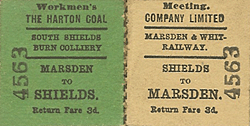 |
Following the opening of the coast road a bus service (later trolley busses) ran to Marsden from South Shields which quickly eroded passenger revenue. Before the road opened, the line was covering its costs but by now it was turning into little more than a local curiosity. The only regular Saturday passengers turned out to be mothers with prams because they had |
great difficulty in getting prams onto the buses. The public regarded the use of the train as something of a last resort and it seemed inevitable that the public service would finish, but to the miners the service was still vital. Over 3000 men worked at the pit and many of them lived in South Shields and relied on the railway to get them to and from work. WW2 brought a stay of execution when the seafront and coast road was closed as a defensive measure, which meant that the 'Rattler' continued to provide a full passenger service and in fact provided more trains than it had ever done before.
On January 1, 1947, the Harton Coal Company was vested in the National Coal Board, and so the SSM&WCR. became the first nationalised passenger line. The passenger service was always run to suit the convenience of the mineworkers and just prior to closure consisted of of 12 trains daily in each direction. The busiest time was in the afternoon, when four trains left Westoe Lane between 2 p.m. and 5.15 p.m. A more meagre timetable was in operation at weekends, with no trains on Saturday afternoons, and a very long gap on Sundays as the line was no longer attracting tourist traffic following the opening of the coast road. The railway practically closed down during local holiday periods, except for early morning trains for maintenance workers at Whitburn Colliery.
In 1953 the N.C.B. announced plans to upgrade the colliery at Westoe. |
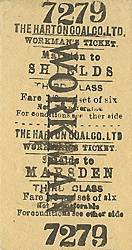 |
The first part of the plan was to build a new £1 million coal washer that could handle the entire production of the collieries in the area and elsewhere. The coal was delivered by British Railways to an exchange siding and brought though Westoe Lane station by new electric locomotives. Westoe Lane had always been a bottleneck and the influx of coal from other areas meant a huge increase in the number of train movements, so to provide an unobstructed path to the washery it was decided to withdraw the passenger service from 23rd November 1953. The service was replaced by buses to take the miners to Whitburn colliery on Monday 14th November but for some reason the rail service continued to operate for one more week. It was reported that the last scheduled train ran on 22nd November departing Westoe Lane at 9.58pm and it was probably empty.
 |
The railway and Whitburn Colliery laboured on into the 1960's, but during 1965 the N.C.B. sold off the two Marsden quarries, and that soon brought an end to the rail movement of limestone, as lorries took over deliveries immediately. Also during 1965 the N.C.B. brought in three new diesel locomotives to replace all the steam engines which had over the years given sterling service. These diesels were put to work 24 hours a day, 7days a week during a seaman's strike in 1966, which closed the Harton Staiths for quite a while. Whilst the strike was taking place it was decided to use Whitburn colliery to stockpile all of the coal produced by the Harton pits. This lead to intense activity on the railway the like of which was never to be seen again.
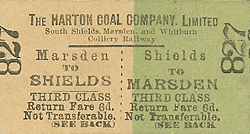 |
In October 1967 a rumour spread like wildfire amongst the Whitburn colliers that both Harton and Whitburn pits were earmarked for closure as part of the general rundown of the coal industry. Then in January 1968 NCB management warned the workforce that a weekly target of 6,500 tons of coal had to be reached to avoid closure. By 21st May the miners managed |
to exceed the target by 41 tons. Two weeks later the pit shut down and 819 men were put out of work.
The last shift was worked on the 7th June 1968 and the pit and railway was officially abandoned the next day. There were in fact a few more loads of coal moved up the line to Westoe and the last passenger train to use the line was a hastily arranged rail enthusiasts' special organised by Manchester Locomotive Society, and Stephenson Locomotive Society, which ran on 7th September 1968. The 'Durham Coast Rail Tour' covered not just the Marsden Railway but the entire Harton System. The Flying Scotsman brought 250 enthusiasts to Tyne Dock station where they transferred into a train of open wagons at Dean Road sidings headed by an English Electric locomotive for a tour of the electrified system, The NCB electric was exchanged for a pair of NCB diesels at Westoe (in 'top and tail' formation) for the journey down to the deserted Whitburn Colliery.
| The closure of the colliery also meant the the end of village life at Marsden. In the 1950's, erosion damaged the cliffs and Marsden village was in danger of slipping into the sea. People moved into new modern houses in Whitburn and the surrounding areas. Several years befoe the mine closed for good, the village was demolished. The area is now part of Whitburn Coastal |
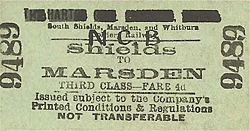 |
Park and is managed by the National Trust.
The line through Westoe Lane Station remained in use until 1993 when Westoe Colliery closed. The last remaining section of track was lifted in 1994 although still appearing on local street maps until very recently. It is still shown on some on-line mapping today 15 years after it was lifted.
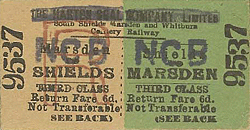 |
Today there is little evidence of the Marsden Railway. The coast road has been widened across the track for much of its course obliterating all evidence of the line. Whitburn Colliery has been cleared completely and now forms part of the Whitburn Coastal Park. A range of kilns still stands on the east side of Marsden Quarry and the course of the branch line serving the quarry |
can still be made out. The only evidence of the Marsden branch itself is a single abutment of the substantial bridge over the coast road near the Souter Point lighthouse (the bridge was demolished in 1969), the Marsden line has almost vanished without trace.
Sources:
Further reading: The South Shields Marsden & Whitburn Colliery Railway by William J. Hatcher. Oakwood Press 2002 ISBN 978-0-853615-83-5. See also Marsden Banner Group web site for a detailed history of the mining community at Marsden. Many interesting pictures.
Web sites: Railways of Britain - The Harton Electric Railway, Durham Mining Museum - Whitburn Colliery, The Westoe Electrics, BBC Home - Marsden the village that vanished.
Tickets from Michael Stewart except 3567 Brian Halford - Click here for more tickets
To see other stations on the South Shields Marsden & Whitburn Colliery Railway click on the station name: Marsden Cottage, Marsden (1st site) &
Marsden (2nd site) |

old3.jpg)
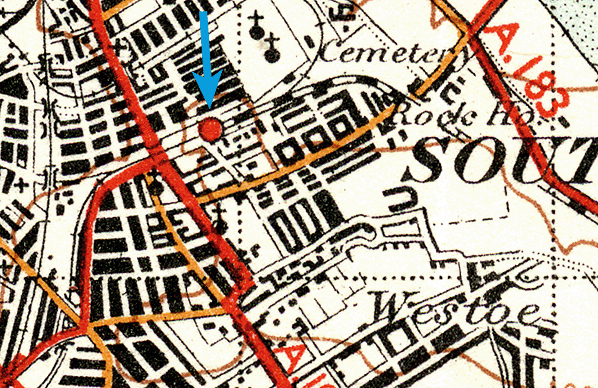
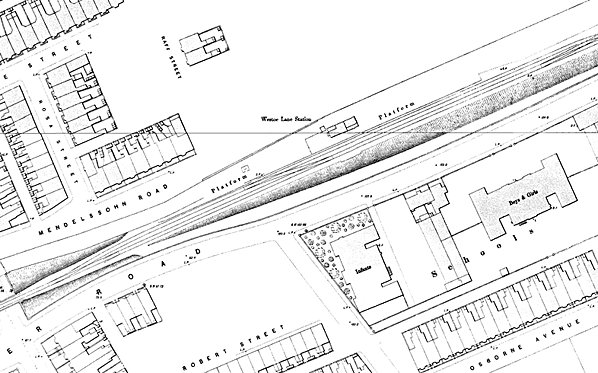
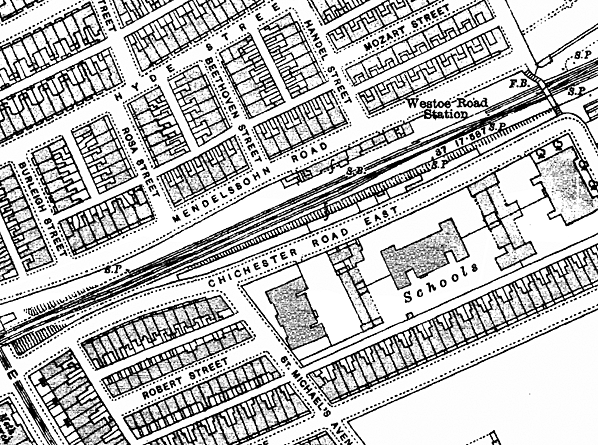
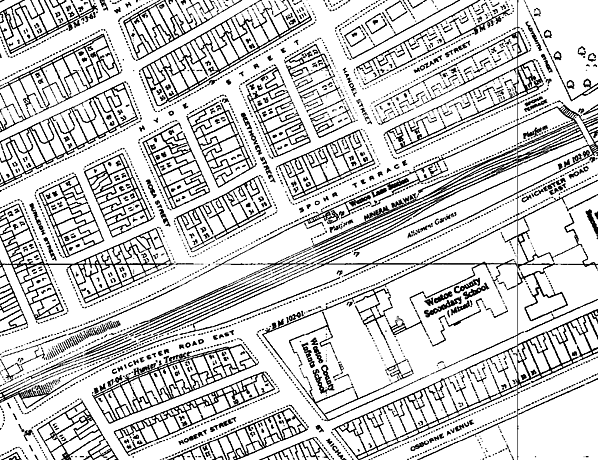
old1.jpg)
old2.jpg)
old5.jpg)
old6.jpg)
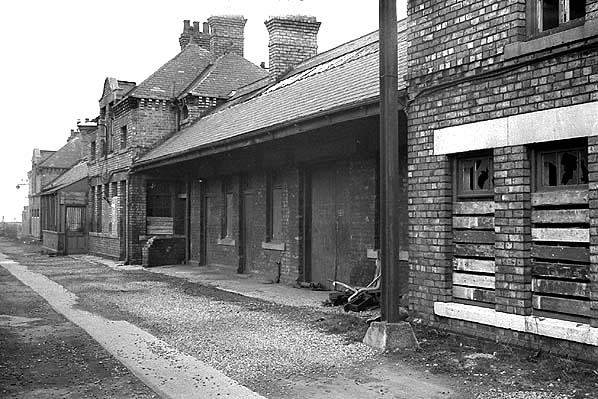
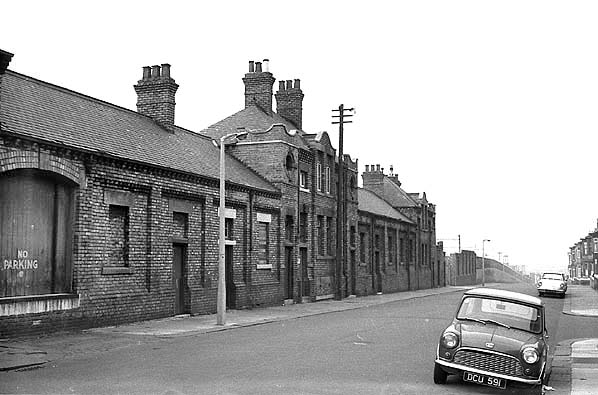

 Home Page
Home Page 











